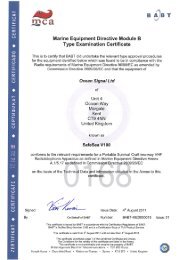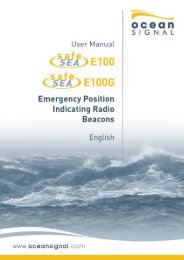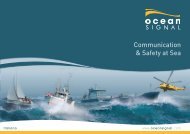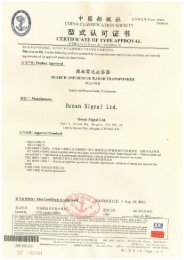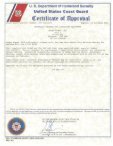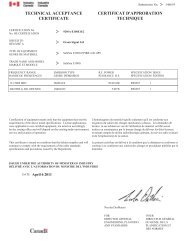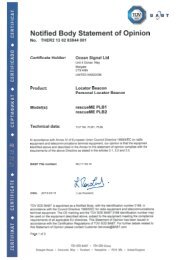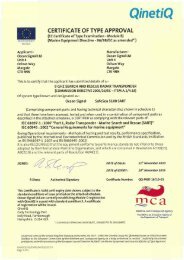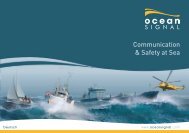SafeSea Product Brochure (English) - Ocean Signal
SafeSea Product Brochure (English) - Ocean Signal
SafeSea Product Brochure (English) - Ocean Signal
You also want an ePaper? Increase the reach of your titles
YUMPU automatically turns print PDFs into web optimized ePapers that Google loves.
Communication<br />
& Safety at Sea<br />
<strong>English</strong><br />
www.oceansignal.com
Introducing <strong>Ocean</strong> <strong>Signal</strong><br />
<strong>Ocean</strong> <strong>Signal</strong> ® specialises in the development and<br />
manufacture of advanced communication and safety<br />
products for the marine market.<br />
With one of the most experienced<br />
research and development teams in<br />
marine communications, the <strong>Ocean</strong><br />
<strong>Signal</strong> engineering team have individually<br />
been responsible for the development<br />
of many market-leading products<br />
and now within <strong>Ocean</strong> <strong>Signal</strong>, bring a<br />
fresh and groundbreaking approach to<br />
communication and safety at sea.<br />
<strong>Ocean</strong> <strong>Signal</strong> has one of the finest<br />
marine communication R&D facilities in<br />
Europe. Each new product is the result<br />
of meticulous research and extreme<br />
testing procedures to ensure outstanding<br />
performance. This process ensures fully<br />
focused product functionality<br />
while providing total confidence in<br />
their effectiveness.<br />
Offering exceptional value, the<br />
<strong>Ocean</strong> <strong>Signal</strong> range of products give<br />
commercial, fishing and recreational<br />
users the confidence that their<br />
equipment will work to, and beyond<br />
their expectations, in the harshest of<br />
conditions, when it is needed most.<br />
Well equipped testing facilities<br />
RF Anechoic testing chamber
The<br />
Range<br />
The <strong>SafeSea</strong>® range of products from <strong>Ocean</strong> <strong>Signal</strong><br />
provide all essential handheld communication devices<br />
required in an emergency situation.<br />
All products comply with international<br />
requirements of the IMO (International<br />
Maritime Organisation) which lay down<br />
essential requirements for products<br />
operating in the GMDSS (Global Maritime<br />
Distress Safety System).<br />
The <strong>SafeSea</strong> E100 & E100G are EPIRBs<br />
(Emergency Position Indicating Radio<br />
Beacons) which, when activated,<br />
transmit a distress signal and position<br />
directly to the emergency services<br />
via satellites. The accuracy of this<br />
information is enhanced by a built in GPS<br />
within the model E100G.<br />
The <strong>SafeSea</strong> S100 is a SART (Search And<br />
Rescue Transponder), which assists in<br />
the location of survival craft by providing<br />
a series of indicating marks on all ships<br />
operating X-band radar in the vicinity.<br />
The <strong>SafeSea</strong> V100 is a handheld VHF<br />
designed to rigorous standards. The<br />
V100 can be relied upon to provide local<br />
communication with rescuers in an<br />
emergency situation. The unit is supplied<br />
with a special battery, which is only to be<br />
activated in an emergency. At other times<br />
an optional rechargeable battery can be<br />
used for general day-to-day communication.<br />
www.oceansignal.com
E100 / E100G EPIRB<br />
<strong>Ocean</strong> <strong>Signal</strong> has developed the <strong>SafeSea</strong> E100 and<br />
E100G to meet the needs of all commercial, fishing<br />
and leisure vessels.<br />
The <strong>SafeSea</strong> EPIRBs operate in the<br />
406MHz satellite band. This is constantly<br />
monitored by Cospas-Sarsat, the<br />
international search and rescue satellite<br />
operator, who ensuring a rapid response<br />
when a signal is received, no matter<br />
where it is in the world.<br />
The products have been designed for<br />
maximum efficiency resulting in superb<br />
operating life from the battery, keeping<br />
rescue services updated with your<br />
location for longer.<br />
All models are fitted with a 121.5MHz<br />
homing beacon used by rescue services<br />
for close-in location of vessels in<br />
distress. In addition all models are fitted<br />
with a high brightness LED strobe light<br />
for additional impact, especially at night.<br />
All models can be fitted within an<br />
Automatic Release Housing (commonly<br />
referred to as ‘float free’).
• Choice of models with and without GPS<br />
• <strong>SafeSea</strong> E100G is identical to the <strong>SafeSea</strong> E100 and in addition has a state<br />
of art built-in 50 channel GPS receiver providing fast and accurate position<br />
acquisition (typically within 30 seconds)<br />
• <strong>SafeSea</strong> E100 fulfils all mandatory requirements of an EPIRB. A high<br />
precision internal oscillator allows the satellite to calculate position using<br />
Doppler shift<br />
• Superb battery life even at low temperatures, typically providing an operating<br />
time in excess of 96 hours<br />
• Easy release mounting bracket provided as standard<br />
• Optional manual and automatic release housings available<br />
• Intuitive operating controls (protected from inadvertent activation)<br />
1<br />
Strobe Light<br />
• User replaceable battery<br />
• Battery is non-hazardous for shipping purposes<br />
2<br />
Mounting bracket<br />
3<br />
Operating controls<br />
www.oceansignal.com
E100 / E100G EPIRB<br />
Two optional housings for the <strong>SafeSea</strong> EPIRB are available. Both<br />
are manufactured in a durable and highly UV stable plastic and<br />
provide excellent protection of the unit until it is required.<br />
The EPIRB can be easily removed from<br />
either housing.<br />
• MRH100 manual release housing<br />
• ARH100 automatic release housing,<br />
containing a hydrostatic release<br />
mechanism which automatically deploys<br />
the EPIRB if the vessel is sinking<br />
Note: IMO regulations require an automatic<br />
release housing to be provided for<br />
mandatory fitted EPIRB’s.<br />
Specifications:<br />
Frequency<br />
406.037MHz<br />
Temperature range (class 2)<br />
-20°C to +55°C<br />
Standards (Meets or exceeds<br />
requirements of the following)<br />
IMO A.662(16),A.694(17); A.810(19),<br />
A.814(19); MSC.56(66); MSC.120(74)<br />
C/S T.001, T.007; IEC61097-2,<br />
IEC60945; RTCM SC110<br />
See Web Site for further details of<br />
specification<br />
ARH100 Automatic release housing<br />
EPIRB Mounted with hydrostatic release
S100 SART<br />
The <strong>Ocean</strong> <strong>Signal</strong> <strong>SafeSea</strong> S100 is an X-band radar<br />
transponder which complies with IMO SOLAS<br />
regulations.<br />
• Superb battery operating life, even at<br />
low temperatures<br />
• Provides 12 hours operating use<br />
even after 96 hours in standby<br />
• User replaceable battery<br />
• Battery is non-hazardous for shipping<br />
purposes<br />
• Compact size – ideal for packing<br />
within a life raft canister<br />
• Supplied with telescopic pole and easy<br />
to release mounting bracket<br />
• Intuitive operating controls – identical<br />
to operation of the <strong>SafeSea</strong> EPIRB –<br />
reducing stress in times of emergency<br />
The <strong>SafeSea</strong> S100 SART assists in rescue<br />
and recovery providing an enhanced target in<br />
response to radars operating in the vicinity.<br />
When switched on the S100 remains in<br />
standby mode until automatically activated<br />
by a ship’s X-band radar. It then transmits<br />
a series of pulses which are displayed on<br />
the radar as a line of dots proving range and<br />
bearing to the emergency.<br />
Specifications<br />
Temperature range -20°C to +55°C<br />
Standards (Meets or exceeds requirements of<br />
the following)<br />
IMO A.694(17), MSC.247(83); IEC61907-1, IEC60945<br />
See Web Site for further details of specification<br />
Location of<br />
SART<br />
Typical radar display showing a line<br />
of dots emitted from SART<br />
www.oceansignal.com
V100 VHF Handheld Radio<br />
The <strong>Ocean</strong> <strong>Signal</strong> <strong>SafeSea</strong> V100 handheld VHF is<br />
designed to provide voice communication when it is<br />
needed most – in an emergency.<br />
It meets or exceeds requirements of<br />
rigorous specifications intended to ensure<br />
reliability in arduous conditions.<br />
Ease of use is provided by large keys with<br />
simple ergonomic layout supported by a<br />
large high contrast LCD to confirm operation.<br />
The V100 is provided with a lithium<br />
primary battery which is protected from<br />
inadvertent use by a unique protection tab.<br />
The battery is non-hazardous for shipping<br />
purposes. Battery life is maximised by<br />
utilisation of high efficiency circuitry,<br />
especially in transmit.<br />
For general everyday use the V100 can<br />
be fitted with an optional lithium polymer<br />
rechargeable battery which can be<br />
replenished using a rapid charger (this can<br />
be desk or bulkhead mounted).<br />
The <strong>SafeSea</strong> V100 is available both with<br />
and without an extremely rugged accessory<br />
socket. The socket provides connection<br />
to accessories if required (e.g. helmets,<br />
headsets, extension microphones etc).
• Complies with IMO requirements for survival craft radio<br />
• Superb battery life: provides over 16 hours typical operation even<br />
at low temperatures (10% Tx, 10% Rx & 80% squelched)<br />
• User replaceable battery<br />
• Battery is non-hazardous for shipping purposes<br />
• Fully waterproof, even with 40ºC thermal shock<br />
• Fitted with 21 simplex channels as standard (according to IMO<br />
SOLAS regulations)<br />
• Antenna connection via 50ohm waterproof socket<br />
• 4 scanning modes are provided – dual watch, triple watch, scan<br />
all and memory scan<br />
Specifications:<br />
Transmit power<br />
2.5W<br />
Receiver Sensitivity (for 20dB SINAD<br />
-117dBm<br />
Temperature range<br />
-20ºC to + 55ºC<br />
Standards (Meets or exceeds<br />
requirements of the following)<br />
IMO A.694(17); MSC.14(77)<br />
IEC61097-12, IEC60945<br />
See Web Site for further details of<br />
specification<br />
Emergency Battery<br />
Accessory Socket<br />
Charger<br />
www.oceansignal.com
<strong>Product</strong> Outlines<br />
SART<br />
244mm<br />
230mm<br />
VHF<br />
430mm<br />
212mm<br />
77mm<br />
80mm<br />
91mm<br />
316mm<br />
141mm<br />
162mm<br />
EPIRB<br />
105mm<br />
110mm<br />
121mm<br />
293mm<br />
67mm<br />
70mm<br />
37mm<br />
65mm<br />
126mm<br />
114mm<br />
Housings<br />
196mm<br />
130mm
GMDSS<br />
GMDSS is an internationally operated system for<br />
Safety of Life at Sea (SOLAS). Developed by the<br />
International Maritime Organisation, the GMDSS was<br />
originally conceived for commercial shipping, but the<br />
systems used are equally applicable to all maritime<br />
users. The underlying principle is that ships should<br />
have at least two means of transmission of a distress<br />
alert to both shore infrastructure and to other ships.<br />
Additional equipment is carried to provide location<br />
and communication aids for use during the search<br />
and rescue phase. The <strong>SafeSea</strong> range of products<br />
from <strong>Ocean</strong> <strong>Signal</strong> provides a total solution for this<br />
class of equipment.<br />
EPIRB – how it works<br />
<strong>Ocean</strong> <strong>Signal</strong> EPIRBs operate in the 406MHz<br />
satellite band monitored by Cospas-Sarsat,<br />
ensuring a signal can be located wherever it is<br />
activated around the globe.<br />
On activation, the EPIRB commences<br />
transmission of a distress alert, which is picked<br />
up by two groups of satellites. The geostationary<br />
(GEOSAR) satellites will typically receive the alert<br />
first, but these satellites do not have the ability<br />
to generate location information and do not cover<br />
the Polar Regions.<br />
LEOSAR Satellites<br />
The second group of low earth orbiting (LEOSAR)<br />
satellites give complete global coverage, including<br />
the Polar Regions. As each satellite passes over<br />
an active EPIRB, it can calculate the approximate<br />
location (typically within 5Nm) of the beacon, using<br />
Doppler processing of the signal.<br />
The satellites pass the received alerts to Cospas-<br />
Sarsat headquarters, where it is then passed to the<br />
relevant National Rescue Coordination Centre.<br />
EPIRB without GPS: The <strong>SafeSea</strong> E100 EPIRB will<br />
have initiated a rescue attempt almost immediately<br />
after activation, but because of the nature of the<br />
satellite location process your position may not be<br />
known for some time afterwards as it depends on<br />
the orbit of the LEOSAR satellites which can take up<br />
to an hour to come into view.<br />
EPIRB with GPS: The <strong>SafeSea</strong> E100G EPIRB will<br />
transmit its known location as soon as a position<br />
fix has been obtained by the built-in GPS. These<br />
transmissions will be picked up by both types of<br />
satellite. This provides two significant advantages.<br />
• Immediate location of the vessel in distress<br />
• Excellent positional accuracy of the distress<br />
GEOSAR Satellites<br />
Whilst every effort has been made to ensure the information in this brochure is accurate,<br />
products and specifications may be changed without notice.<br />
www.oceansignal.com
<strong>Ocean</strong> <strong>Signal</strong> Ltd.<br />
Unit 4, Ocivan Way<br />
Margate<br />
CT9 4NN<br />
United Kingdom<br />
info@oceansignal.com<br />
www.oceansignal.com<br />
+44 1843 282930



